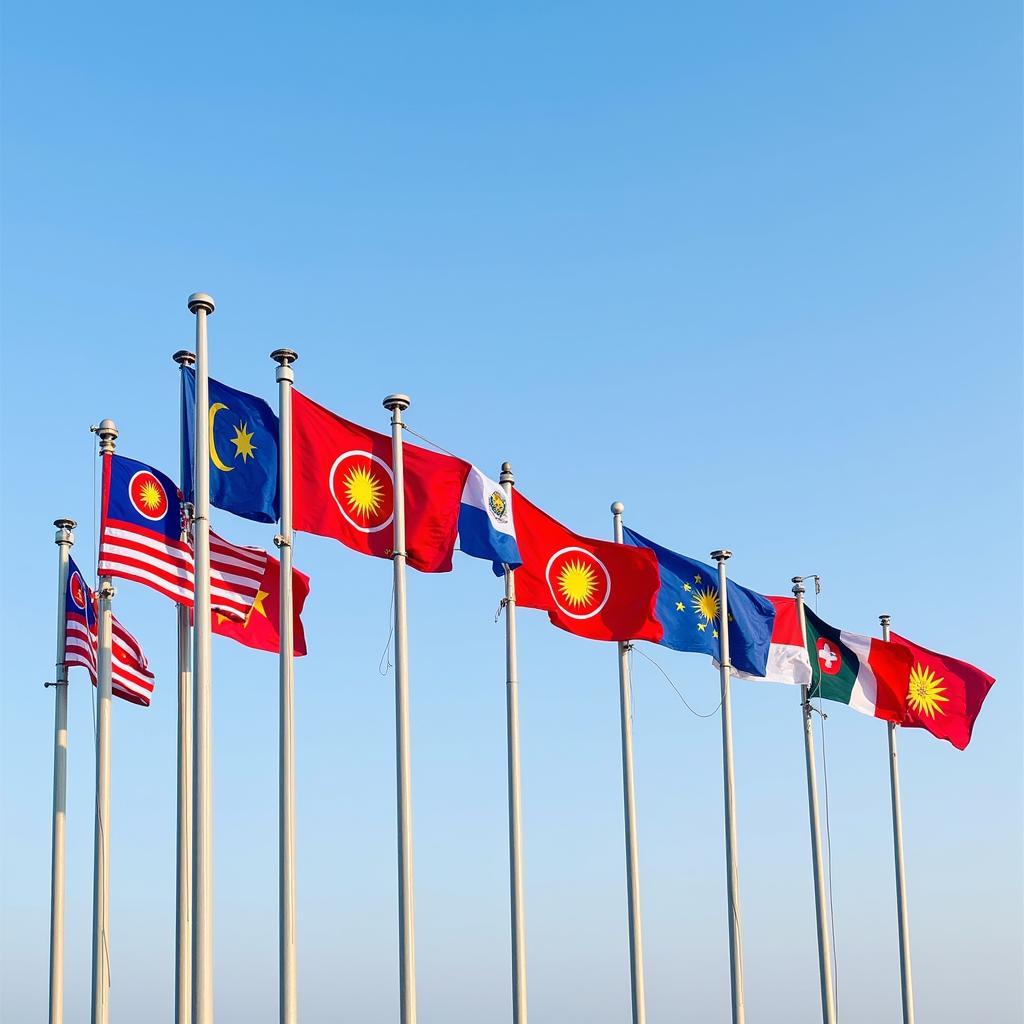The concept of “Asean united” represents a vision of Southeast Asia where the 10 member states collaborate seamlessly to achieve common goals. This unity is crucial for the region’s economic growth, political stability, and social progress. As individual nations, ASEAN countries are diverse and vibrant, but together, they form a formidable force on the global stage.
 ASEAN flags waving together in unity
ASEAN flags waving together in unity
The Pillars of Asean Unity
The Association of Southeast Asian Nations (ASEAN) is built on fundamental principles that guide its actions and foster a sense of community. These key pillars include:
- Mutual respect for sovereignty: ASEAN nations acknowledge and respect each other’s independence and territorial integrity, promoting peaceful coexistence and cooperation.
- Non-interference in internal affairs: Member states refrain from meddling in the domestic matters of others, fostering an environment of trust and stability.
- Peaceful settlement of disputes: ASEAN encourages dialogue and diplomacy to resolve conflicts peacefully, rejecting the use of force and promoting regional harmony.
- Renunciation of the threat or use of force: Member states are committed to resolving differences through peaceful means, contributing to a secure and stable Southeast Asia.
- Effective cooperation: ASEAN prioritizes collaboration in various sectors, leveraging collective strengths to address shared challenges and achieve common goals.
These core principles provide a solid foundation for “Asean united” and guide the region towards greater integration and shared prosperity.
Economic Integration: A Driving Force for Asean United
One of the most significant aspects of “Asean united” is the region’s commitment to economic integration. The ASEAN Economic Community (AEC) aims to establish a single market and production base, promoting the free flow of goods, services, investments, and skilled labor.
Benefits of Economic Integration:
- Increased trade and investment: Lowering trade barriers and streamlining customs procedures facilitates trade and attracts foreign direct investment, boosting economic growth.
- Enhanced competitiveness: By operating within a larger single market, ASEAN businesses can achieve economies of scale, improve efficiency, and become more competitive globally.
- Job creation and economic opportunities: Economic integration generates new jobs and business opportunities, raising living standards and reducing poverty across the region.
- Regional supply chain resilience: A more integrated ASEAN economy strengthens regional supply chains, making them more resilient to global economic shocks.
Socio-Cultural Cooperation: Strengthening Bonds Within Asean United
Beyond economics, “Asean united” extends to fostering closer socio-cultural ties among its people. This collaboration aims to preserve the region’s rich cultural heritage while addressing shared social challenges.
Key Areas of Socio-Cultural Cooperation:
- Education and human resource development: ASEAN promotes educational exchanges, scholarships, and skills development programs to enhance the quality of human capital in the region.
- Cultural exchange and preservation: Initiatives to promote cultural understanding include art festivals, film screenings, and literary events, showcasing the diversity and vibrancy of Southeast Asian cultures.
- Environmental protection: Recognizing the interconnectedness of environmental issues, ASEAN collaborates on initiatives to combat climate change, protect biodiversity, and promote sustainable development.
- Disaster management and humanitarian assistance: ASEAN has established mechanisms for cooperation in disaster preparedness, response, and relief efforts, strengthening regional resilience to natural disasters.
 Traditional dancers from different ASEAN countries performing together
Traditional dancers from different ASEAN countries performing together
Challenges and Opportunities for Asean United
While ASEAN has made significant strides in fostering unity and cooperation, challenges remain. Addressing these is crucial for realizing the full potential of “Asean united.”
Key Challenges:
- Development gaps: Economic disparities exist between ASEAN member states, requiring targeted efforts to bridge the gap and ensure inclusive growth.
- Territorial disputes: Overlapping maritime claims and unresolved border issues pose challenges to regional stability and require peaceful resolution through dialogue.
- Non-traditional security threats: ASEAN faces transnational challenges such as terrorism, cybercrime, and pandemics, necessitating closer cooperation on security matters.
Opportunities for the Future:
- Leveraging digital technology: The digital economy presents vast opportunities for ASEAN, and harnessing its potential can accelerate growth and innovation.
- Strengthening regional connectivity: Improving infrastructure, transportation links, and digital connectivity can further integrate ASEAN economies and societies.
- Enhancing people-to-people ties: Fostering closer relationships between ASEAN citizens through educational exchanges, tourism, and cultural programs can strengthen the sense of community.
Conclusion
“Asean united” represents a powerful vision for a region characterized by collaboration, peace, and shared prosperity. By working together, ASEAN member states can overcome challenges, leverage opportunities, and secure a brighter future for their people and the generations to come.
FAQ
What are the main goals of ASEAN?
ASEAN aims to accelerate economic growth, promote social progress, foster cultural development, and ensure regional peace and security through dialogue and cooperation.
How does ASEAN benefit its member states?
ASEAN membership provides access to a larger market, facilitates trade, attracts foreign investment, enhances regional security, and promotes cooperation on shared challenges.
What is the role of the ASEAN Secretariat?
The ASEAN Secretariat, based in Jakarta, Indonesia, supports ASEAN’s work by coordinating meetings, implementing programs, and facilitating communication among member states.
How can I get involved in ASEAN initiatives?
Individuals can explore opportunities through ASEAN-related organizations, participate in exchange programs, volunteer for NGOs working on regional issues, and stay informed about ASEAN activities.
What is the future outlook for ASEAN?
ASEAN is poised for continued growth and integration, with a focus on digitalization, connectivity, and sustainable development to address emerging challenges and opportunities.
Need further assistance?
Contact us at Phone Number: 0369020373, Email: [email protected] or visit our address: Thon Ngoc Lien, Hiep Hoa, Bac Giang, Vietnam. Our customer service team is available 24/7.

